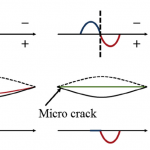Nonlinear effects exhibited by crack-wave interactions can be simulated using different models, for example: bi-linear stiffness (clapping mechanism employing bi-linear stiffness simplifications), hysteresis (phenomenological), rough surfaces contact and non-classical dissipation. In all, the nonlinear mechanisms can be classified according to the material's length scale into microscopic, mesoscopic and macroscopic. Different models cover different levels of simplification, and some physical mechanisms can actually occur simultaneously in real cracks. Different nonlinear phenomena can be observed at different length scales. Thereby, for a sufficient assessment of the importance of nonlinear mechanisms on vibro-acoustic wave modulations, multi-scale modelling is required.
The physics of vibro-acoustic nonlinear phenomena caused by crack-wave interactions can be studied using models of different complexities, describing various physical phenomena. Most of the classical models met in the literature are either of an elastic or dissipative nature. Non-classical models, e.g. an acoustic equivalent of the Luxemburg-Gorky effect involves nonlinear coupling of strain and temperature fields. Therefore, the latter models would require multi-physical tools for numerical simulations.

